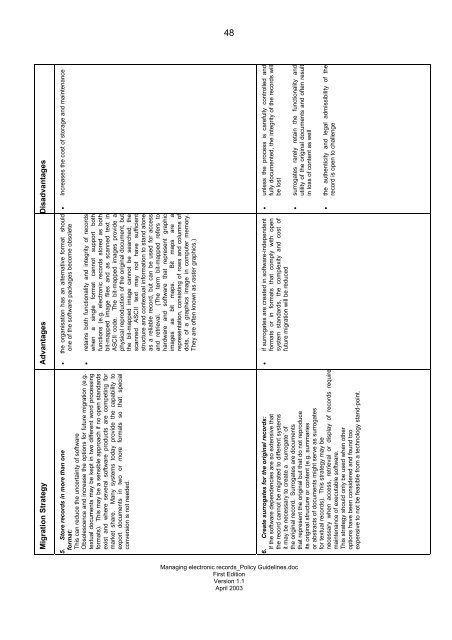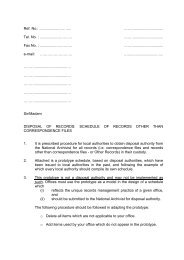managing electronic records in governmental bodies - National ...
managing electronic records in governmental bodies - National ...
managing electronic records in governmental bodies - National ...
Create successful ePaper yourself
Turn your PDF publications into a flip-book with our unique Google optimized e-Paper software.
48<br />
Migration Strategy<br />
5. Store <strong>records</strong> <strong>in</strong> more than one<br />
format:<br />
This can reduce the uncerta<strong>in</strong>ty of software<br />
Obsolescence and <strong>in</strong>crease the options for future migration (e.g.<br />
textual documents may be kept <strong>in</strong> two different word process<strong>in</strong>g<br />
formats). This may be a sensible approach if no open standards<br />
exist and where several software products are compet<strong>in</strong>g for<br />
market share. Many systems today provide the capability to<br />
export documents <strong>in</strong> two or more formats so that special<br />
conversion is not needed.<br />
6. Create surrogates for the orig<strong>in</strong>al <strong>records</strong>:<br />
If the software dependencies are so extensive that<br />
the record cannot be migrated to different systems<br />
it may be necessary to create a ‘surrogate’ of<br />
the orig<strong>in</strong>al record. Surrogates are documents<br />
that represent the orig<strong>in</strong>al but that do not reproduce<br />
its orig<strong>in</strong>al structure or content (e.g. summaries<br />
or abstracts of documents might serve as surrogates<br />
for textual <strong>records</strong>). This strategy may be<br />
necessary when access, retrieval or display of <strong>records</strong> require<br />
ma<strong>in</strong>tenance of executable software.<br />
This strategy should only be used when other<br />
options have been considered and found too<br />
expensive to not be feasible from a technology stand-po<strong>in</strong>t.<br />
Advantages<br />
• the organisation has an alternative format should<br />
one of the software packages become obsolete<br />
• reta<strong>in</strong>s both functionality and <strong>in</strong>tegrity of <strong>records</strong><br />
when a s<strong>in</strong>gle format cannot support both<br />
functions (e.g. <strong>electronic</strong> <strong>records</strong> stored as both<br />
bit-mapped image files and as scanned text <strong>in</strong><br />
ASCII code. The bit-mapped images provide a<br />
physical reproduction of the orig<strong>in</strong>al document, but<br />
the bit-mapped image cannot be searched; the<br />
scanned ASCII text may not have sufficient<br />
structure and contextual <strong>in</strong>formation to stand alone<br />
as a reliable record, but can be used for access<br />
and retrieval. (The term bit-mapped refers to<br />
hardware and software that represent graphic<br />
images as bit maps. Bit maps are a<br />
representation, consist<strong>in</strong>g of rows and columns of<br />
dots, of a graphics image <strong>in</strong> computer memory.<br />
They are often known as raster graphics.)<br />
• if surrogates are created <strong>in</strong> software-<strong>in</strong>dependent<br />
formats or <strong>in</strong> formats that comply with open<br />
system standards, the complexity and cost of<br />
future migration will be reduced<br />
Disadvantages<br />
• Increases the cost of storage and ma<strong>in</strong>tenance<br />
• unless the process is carefully controlled and<br />
fully documented, the <strong>in</strong>tegrity of the <strong>records</strong> will<br />
be lost<br />
• surrogates rarely reta<strong>in</strong> the functionality and<br />
utility of the orig<strong>in</strong>al documents and often result<br />
<strong>in</strong> loss of content as well<br />
• the authenticity and legal admissibility of the<br />
record is open to challenge<br />
Manag<strong>in</strong>g <strong>electronic</strong> <strong>records</strong>_Policy Guidel<strong>in</strong>es.doc<br />
First Edition<br />
Version 1.1<br />
April 2003
















